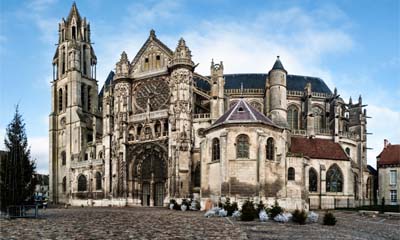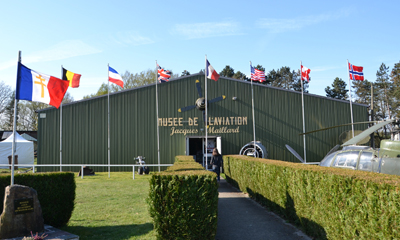Visites, Monuments, Musées.. Oise
Chantilly and proximity |
|
Le Château de Chantilly |
|
| This Castle dating from the Renaissance rises out of the water, with residences for the Princes of Condé (XVII and XVIII century). The park was designed by André Le Nôtre and created in the 16th century by the High Constable Anne de Montmorency. Part of the chateau was re-built in 1875 by the Duc d’Aumale, son of King Louis-Philippe. Chantilly, with its Condé museum, has the finest French collection of old masters outside the Louvre. On display are The Three Graces (Les Trois Grâces), by Raphaël, The Very Rich Hours (Les Très Riches Heures), by the Duke of Berry and The Serenade Giver (Le Donneur de Sérénades) by Watteau. The library unites a unique collection of medieval manuscripts. It is also renowned by its famous museum living on the horse. |  |
La Cathédrale Notre Dame de Senlis |
|
| Marked by four centuries of changes, Notre-Dame de Senlis cathedral represents evolution of Gothic style. Most of the Cathedral was built during the second half of the 12th century. After a fire in 1504, the transept was rebuilt, with a profusion of decorative features that are symbolic of the flamboyant Gothic period. A jewel of 12th-century sculpture, the west portal represents the triumph of Mary for the first time. After long and meticulous restoration, these sculptures now show their original colours. |  |
Le Musée d'Art et d'Archéologie de Senlis |
|
| Made up of collections from the 19th century, set up in the early 1980s in the former pope's palace. The vaulted cellars feature remarkable votive offerings, the remains of a Gallo-Roman habitat and 3rd century ramparts. On the ground floor there is a display of archaeology, including a bronze base dedicated, in 48 A.D. to the Emperor Claude. A Gothic room has Middle Age sculptures and religious items. Upstairs are paintings from the 17th to 20th centuries; one section is devoted to Thomas Couture and the other to modern primitive art by Seraphine de Senlis. |  |
Le Musée Gallé-Juillet |
|
| The Gallé-Juillet museum is located on the ruins of the fortified castle in Creil. Furniture, paintings, works of art and old toys from the 18th and 19th century, along with a fine collection of earthenware from Creil and Montereau. Located near to the Oise River and surrounded by a French garden, the house is a fine example of provincial 19th-century bourgeoisie. |  |
L'Abbatiale de Saint-Leu-d'Esserent |
|
| This Benedictine Abbey was built in the XIth and XIIth century and dominates the medieval town. There is a remarkable recumbent figure of Renaud de Boulogne count of Dammartin in the abbey. |  |
Le Musée de l'Abbaye Royale de Chaalis |
|
| Jacquemart-André Museum. Over 6000 works of art, pieces of furniture, paintings, sculpture and objects of decoration. 12th and 13th century abbey and chapel, 18th century castle. Rose gardens and park. |  |
Compiègne and proximity |
|
Le Palais Impérial |
|
| Imperial Castle built during the times of Louis XV, and used as an autumn residence during the second empire. Royal and Imperial suites; Museum of the second empire and Museum of Empress Eugenie, National Museum of the Car and Tourism; The Castle Grounds and magnificent English garden. |  |
Le Musée Antoine Vivenel |
|
| Antoine Vivenel, founder of the museum in 1839, gathered a fine collection of works of art that show his love for Antiques, the Renaissance Period and Art of his times. There is an exceptional collection of painted vases displaying the theme of ancient Greece. Enamel from Limoges, Earthenware from Palissy, Glassware from Venice, Majolicas from Italy, Ceramics from the Rhine, Pewter from Nuremberg are all examples of European Renaissance art. Along with all of these are paintings, sculptures and works of art from the 18th and 19th centuries. |  |
Le Château de Pierrefonds |
|
| Built in the 15th century by Louis d'Orléans, dismantled in the 17th century and then rebuild by order of Napoleon III, this is a wonderful interpretation by Viollet-le-Duc. It offers an unforgettable visit: a full fortress defence system and imperial apartments. Inside there is a collection of ornamental masterpieces by MONDUIT. The recumbent statues in the basement take visitors on a journey through history, where sound and projections bring these statues to life! Castle |
 |
La Cité des Bateliers |
|
| Discover life and little known traditions of the "water people". The first scenographic space about handcrafted inland water shipping and transportation in 5 dimensions: sonor booths, walks at the waterside, lock, Freycinet narrowboat... Cite des Bateliers |
 |
Beauvais and proximity |
|
Le Musée départemental de l'Oise |
|
| Located in the Ancient Episcopal Palace, the museum displays collections of medieval sculpted stones and wood, Renaissance paintings from the contemporary period, Art nouveau furniture and Delaherche ceramics. Temporary exhibitions, conferences, guided tours, workshops for children and events are regularly organised. |  |
La Maladrerie Saint Lazare |
|
| The former Saint-Lazare hospital, which provides a remarkable example of Middle-Age hospital architecture, is experiencing a rebirth today. The only one of its kind due to its size (3 hectares) and the wealth of its construction, it is currently undergoing vast restoration work. The grange has just recovered its original beauty. It measures 740m2 and dates from the 13th century and is remarkable due to its dimensions and its magnificent oak framework. As of spring, visitors will be able to enjoy the garden, inspired by medieval times, created close to the grange. |  |
La Cathédrale Saint Pierre |
|
| St Pierre Cathedral in Beauvais, is a rare example of a Carolingian Cathedral, with surprising and original proportions. Various disasters which happened during construction, including the collapse of the 153 m high spire in the 16th century, have left the cathedral without a nave. The 13th century Gothic chancel, like a glass cage standing proudly 48.5m high, is a sublime example of Gothic style. Full of clockmaking techniques dating from the 19th century, the Astronomical Clock of Saint Pierre’s Cathedral, Beauvais, was created in 1865 by A.L Vérité, with no less than 90 000 perfectly synchronised parts. |
 |
Le Château de Boury-en-Vexin |
|
| Benedictine Abbey founded in 661. The abbey is a remarkable example of transition from Roman to Gothic style, with its Sainte Chapelle, a replica of the Sainte Chapelle of Paris built by Saint-Louis, being in pure rayonnant Gothic style.The Sainte Chapelle in the apse of the abbey is a replica of the Sainte Chapelle in Paris. |  |
L'Abbaye de Marquemont |
|
| Marquemont abbey holds a dominating position over the Troësne valley and the plain spreading towards the North. The bell tour built of white stone and roofed with pink tiles can be seen from miles away. Near to the entrance and above the portal, there is a blind window dating from the 11th century. It is decorated with wolf teeth arcades, each of which ends with a grimacing face carved into the stone. |  |
Musée de l'Aviation |
|
| A display covering 650 m2 with a number of documents, personal belongings, 900 aircraft parts, models, and three aeroplanes, an English DCA and a vidoe room with projection of a film from 1939-1945. Museum |
 |
L'abbatiale de Saint-Germer-de-Fly |
|
| Benedictine Abbey founded in 661. The Sainte Chapelle in the apse of the abbey is a replica of the Sainte Chapelle in Paris. The abbey is a remarkable example of transition from Roman to Gothic style, with its Sainte Chapelle, a replica of the Sainte Chapelle of Paris built by Saint-Louis, being in pure rayonnant Gothic style. |  |
Published in
Tourisme




